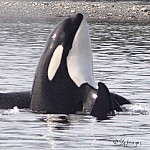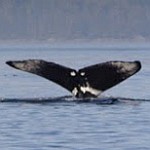Harbour Porpoise
Estimates of the Harbour porpoise population from aerial and boat surveys indicate a large population that appears to be increasing here in B.C. However, the populations of Harbour porpoise have declined in certain areas. The greatest threat to Harbour porpoise are entanglement in fishing nets. With some technology and better methods utilized in fishing to minimize porpoise entanglements, the number of porpoise caught in fishnets per year have decreased over the years.
Dall’s Porpoise
Studies conducted on Dall’s porpoise indicate a large population in the North-East Pacific off of Alaska, British Columbia, and Washington. Occasionally, Dall’s porpoise are caught in fishing nets but the overall effect on the population size is negligible.
Pacific White-Sided Dolphin
Pacific White-Sided dolphins are extremely abundant in the eastern North Pacific area. Pacific White-Sided dolphins are occasionally caught in fishing nets along the West Coast of North America but the population size is unaffected by these deaths.
Minke Whale
Minke whales are found world-wide. However, surveys of Minke whales in British Columbia waters indicate they are not abundant. Approximately 50 individual Minke whales have been identified and cataloged in B.C. waters. The greatest threat to these whales is entanglement in fishing gear and possible ship strikes.
Gray Whale (Grey Whale)
Gray whales were hunted and were close to extinction when an international agreement was reached in 1946 to protect them. Since then, the population of Gray whales has rebounded and is currently estimated around 20000 animals in the North-East Pacific. Threats to Gray whales include entanglement in fishing nets and vessel strikes, similar to other Baleen whales. The migration routes of Gray whales overlap with many shipping routes on the West Coast of North America, and since they are relatively slow swimmers, it is likely that vessel strikes may increase.
Humpback Whale
The population of Humpback whales world-wide appears to be large and healthy. Humpbacks whales were endangered due to commercial whaling and the population has rebounded since the banning of commercial whaling in 1966. Off British Columbia waters, the recovery of Humpback whales has been very evident as sightings of them have steadily increased over the past two decades. Presently, it is estimated that about 3000 to 4000 Humpback whales frequent the waters of B.C. Threats to Humpback whales include entanglement in fishing nets and vessel strikes. Many Humpbacks have scars caused by nets, fishing lines, prawn gear, and boats. More could be done to minimize these threats.
Orca – Killer Whales
The number of Orca (all types) found in the North-East Pacific has been estimated to be between 3000 to 4000 animals. The Northern Resident Orca population is close to 300 animals and has been classified as a Threatened population. The Southern Resident Orca population is numbering close to 70 but is in slow decline, hence it has been classified as an Endangered population. The Transient Biggs Orca found regularly in inland waters number around 300 and is considered a Threatened population. Threats to these populations included vessel strikes, decrease in prey availability, and pollution (e.g. from oil spills). Since Orca are found at the top of the food chain, their health is affected the most from biomagnification of pollutants.


